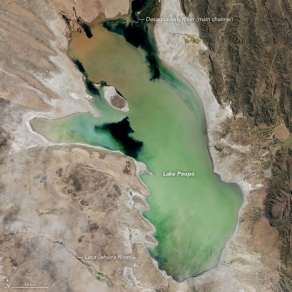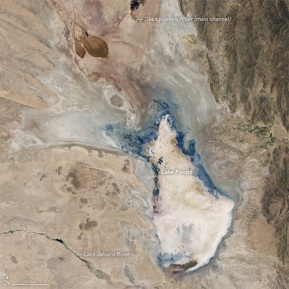The Human Hothouse Turns Bolivia’s Second Largest Lake into a Withered Wasteland
25
January, 2016
Lake Poopo in Bolivia has dried up. And Climate Change has been named as the top cause of the нdisaster.
After
decades of drought and depressed rainfall related to a human-forced
warming of the globe, the once-massive lake is now gone. Once
measuring 90 by 32 kilometers and covering an area of over 1,000
square kilometers this second largest lake in all of Bolivia has
turned into a dried out disaster zone.
Cracked, baked earth, overturned and abandoned boats, and the
desiccated remains of lake life are all that are left as sign to the
fact that a giant lake once existed. The flamingos, fish and other
wildlife that relied on the lake are now dead or long gone. Yet more
lonely casualties of a climate changed radically by an incessant
burning of fossil fuels.
(Human-forced
climate change is implicated in Bolivia’s loss of Lake Poopo. Video
source:TeleSUR
English.)
Rainy
Season Undone
About
a decade ago, the rainy season in this region of the Altiplano
Mountains began to dry up. Rainfall became less regular and the great
Lake Poopo — important to locals for its supply of fish and
wildlife — began to fade away. By 2015, record global temperatures
and El Nino conditions had again pushed the rainy season back. By
January of 2016, one month into the typical rainy season, no rains
had yet fallen and the great lake had dried up completely.
According
to NASA,
ongoing drying impacts related to warming have been impeding the flow
of water into Lake Poopo for decades. The first time the lake dried
out was back in 1994. The lake subsequently took more than three
years to re-fill. But it has never fully recovered.
Rates
of Evaporation Increase by a Factor of 3
Rising
global temperatures are increasing the rates of evaporation and
precipitation worldwide. But Lake Poopo sits in an evaporation and
water loss hot spot. Scientists researching this drying
event indicate
that impacts to the hydrological cycle as a result of a human-forced
warming of the globe have increased rates of evaporation for the Lake
Poopo area by 3 times that of the 20th Century average.
And this greatly intensified baking of the lands there has resulted
in a profound loss of reliable water supply for the lake.
(Lake
Poopo before and after. A merciless and ongoing decadal drought has
caused lake Poopo to turn into a dried up desert. Image source: Earth
Observatory.)
Long-term
Outlook Looks Pretty Amazingly Bad
Since
Bolivia occupies a region very vulnerable to the human-forced warming
of our world, the current drying of Lake Poopo may last longer than
the 1994 event or, perhaps, indefinitely. Bolivian officials seem
determined to restore water to the lake — estimating that such a
project would require the diversion of other sources along with a 150
million dollar investment.
But
the situation is now far more challenging than during the time
following the initial drying event of 1994. Global temperatures are
in the range of 0.5 C hotter. Meanwhile, trends toward drying are
settling in all over this region of South America. Bolivia’s
first largest lake — Titicaca — is also under threat, require a
half a billion dollars to preserve its own falling water levels.
Sao Paulo, to the east, is still undergoing its own severe water
crisis. And to the north, the loss of moisture due to a deforestation
and warming of the Amazon Rainforest is further exacerbating extreme
drying events throughout South America.
Given
this changing local and global environment, any lake restoration
efforts will meet with extremely severe challenges. Over the next two
decades, global temperatures may spike above 1.5 C above 1880s
averages and the Amazon may be well on its way to collapse. It’s
difficult to imagine that many lakes and rivers would survive such
brutal conditions, much less the very vulnerable Lake Poopo.
Links:
Hat
Tip to Andy in San Diego


No comments:
Post a Comment
Note: only a member of this blog may post a comment.